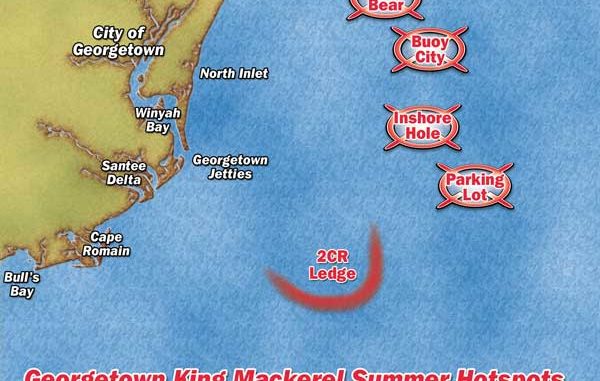
Winyah Bay’s nutrient-rich outflow triggers some great summer fishing for king mackerel.
Notorious for exploding on a bait at lightning speed and taking several hundred yards of line off a reel in a flash, king mackerel are within reach of the weekend angler from the coast off Georgetown. Just as kings have to compete with other bullies on the playground for the available baitfish, fishermen targeting them must change tactics and often change areas to bring home fresh mackerel steaks for an evening cookout.
Georgetown’s access to the ocean is Winyah Bay. Draining an 11-million acre watershed, the bay is fed by four rivers systems: the Black, Sampit, Waccamaw and Pee Dee. They transfer a slug of nutrient-rich water into the ocean each day, sweeping thousands of pounds of baitfish and crustaceans past the mile-long jetties and into the open water. Few other areas along the eastern seaboard carry the volume of biomass into the ocean through one opening.
King mackerel and other large predators visit the area without much coaxing. Fishermen come from all over to target the trophy kings. Some of the largest king mackerel ever caught along the Atlantic seaboard originate from the coastal waters off Georgetown.
The rivers that empty into the ocean form a series of tidelines well known throughout the region as a magnet for large predator fish. Essentially, tidelines are places where two currents converge, trapping vegetation, foam, and other floating debris. Small fish congregate around these rips for cover and food. Kings slide up to these dinner tables, patrolling and ambushing unsuspecting baitfish.
Many of the 40- to 50-pound kings coming to the Georgetown Marina are duped within these ideal areas. Capt. Englis Glover of Tee to Sea Fishing Charters has a innate love for locating and luring smoker kings to his boat, and tidelines are always at the top of his list for summer kings.
“One of the best locales (in the) summer to find kings is along the tideline at the Inshore Hole (on) a southwest wind. It is one of the first places I start to find kings from early summer through fall,” he said.
Glover (843-655-5459) pulls his baits along tidelines where the color changes. Baitfish stack up in those areas, offering kings something to eat. During the heat of summer, Glover cruises several tide lines, looking for accumulations of bait either working at the surface or below (on his depthfinder).
“Any predator fish, including big smoker kings, will be near the accumulations of bait,” he said.
Thermoclines develop, usually around the middle of June and will continue through the entire summer, concentrating baitfish at a recognizable depth. Glover stays on the lookout for thermocline, paying close attention to the depth of the breaks.
“The bait will be stacked up right at the thermocline with big fat kings lurking nearby,” he said.
With the July heat — often depicted as the peak of the South Carolina summer — water temperatures climb into the upper 80s. The many artificial reefs and shipwrecks peppering Georgetown’s coastal waters become inundated with amberjack and barracudas, which thrive on tropical conditions and submerged structure. Catching kings around reefs becomes challenging when the other predators show up in high numbers. Glover stays away from wrecks and reefs, dodging the gluttonous bait stealers and tackle crooks patrolling these structures.
“As waters get hot, local wrecks and reefs are crawling with barracudas and reef donkeys (amberjacks),” Glover said. “We stay away from these areas or other places well known for these guys. If you catch one of these guys, your chances of a king become slim to none in these areas, and you should move to another spot.”
Glover will usually start at the Inshore Hole and will work around to livebottom areas and/or ledges in the area.
“Barracudas and reef donkeys do occur along ledges and livebottoms, too, but are less likely than (at) artificial reefs and shipwrecks,” he said. “Any heavy structure in summer will hold large groups of these undesirable predators.”
Glover patrols shallow livebottoms and ledges and will head to deeper spots until he finds fish. He usually stays in one place only 20 to 30 minutes.
Because the high water temperatures reduce the feeding behavior of kings and other ocean predators, Glover prefers to fish just after daylight when the water is still cool the overnight cool down.
Higher water temperatures also force fishermen to refine their tactics. Glover always prefers live bait, whether it be mullet, bluefish, Spanish mackerel, menhaden or cigar minnows.
“Kings quickly become picky, and the live bait produces the best results for us during summertime conditions,” said Glover, who drifts slowly, dragging his live baits across ledges and livebottom at various depths, bumping the motor in gear from time to time to keep the lines from becoming tangled.
Conversely, Larry Harvey, captain of The Georgetown Office, stays away from the trials and tribulations of catching live bait. With more than 35 years of ocean fishing under his belt, he goes with rigged dead baits, specifically ballyhoo.
“While live bait may be better under certain conditions, we have good success with the same rigged baits we use for our offshore trips for wahoo and dolphin,” said Harvey, (843-520-6406), who trolls ballyhoo either naked or rigged with skirts in various color skirts, including pink, white, blue, chartreuse, and combinations of each. Harvey also tries to find pods of bait at the surface or well below.
“The kings will be hanging close to the baitfish,” he said.
Harvey pulls baits at the surface and behind planers, targeting depths from 60 to 80 feet. Many of his summertime kings come from the 2CR Ledge and the “Parking Lot.”
Kings are often overlooked as a species to target when sweltering temperatures rarely fall below the 80s. Knowing when to go, which areas to avoid, and what to use will reward anxious mackerel anglers with a pleasurable adventure and a reel-screaming smoker king on the end of the line.

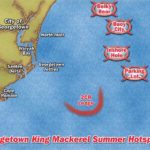
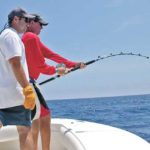
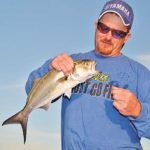
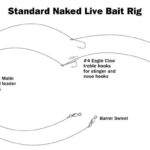
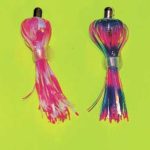
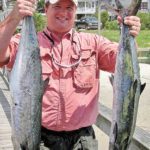



Be the first to comment